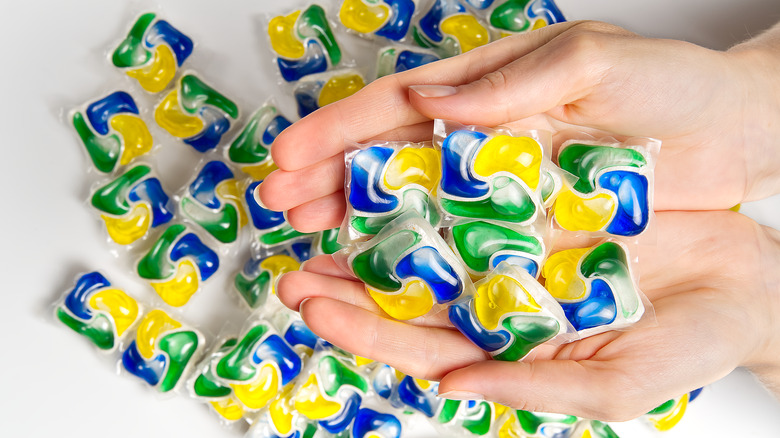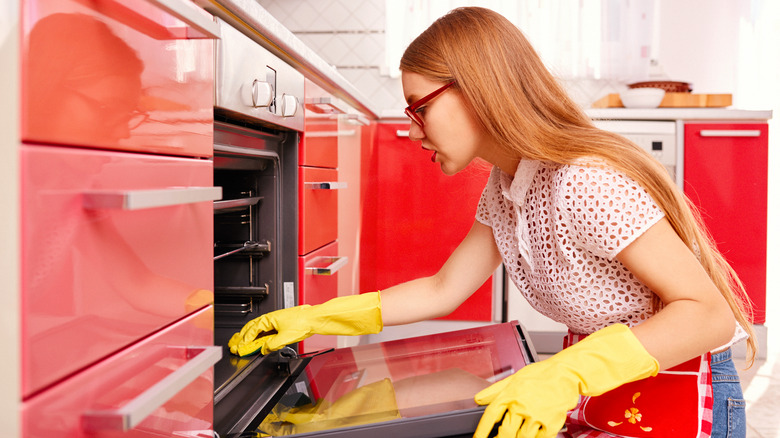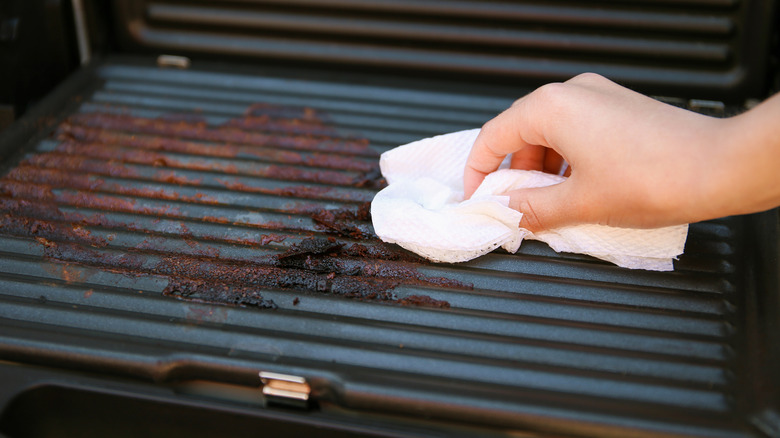Dishwasher Pods Can Clean More In Your Kitchen Than Just Dishes
Who knew we'd one day be breezily pod-ing our way through laundry and dishwashing tasks without a second thought? Since Proctor & Gamble introduced liquid detergent pods to the American consumer in 2012, they've been slowly replacing the way we do things in our kitchen. The previous method of pouring or sprinkling measured amounts of detergent into dishwasher cubbyholes now seems clunkier, slower, and oh-so retro.
But we still may not be grasping the full potential of those perky little pods. There's no need to relegate them to dishwasher magic when there's a whole kitchen waiting to be pod-cleaned. From ovens to refrigerators, small countertop appliances, sinks, and a whole lot more, the possibilities of streamlined cleaning expand at every turn. That's not even counting the extension of your kitchen into outdoor grilling, dining, and all related things needing to stay spiffy clean.
Those little detergent pods suddenly take on a whole new role in your home-care world. And kitchen appliances don't get all the pod glory –– even stationary essentials such as sinks, grout, floors, and cabinets come alive with the cleaning power of pod detergents.
Pod power on kitchen appliances and peripherals
Though designed for cleaning dishes, those kitchen detergent pods do wonders for top-tier kitchen appliances, including refrigerators and ovens. Refrigerators typically need wipe-downs rather than full-depth cleaning, so it's easy to dissolve a pod in a bowl of warm water and proceed as usual with a sponge or soft cloth.
Cleaning an oven is one of the most notoriously avoided kitchen tasks, requiring scrubbing, soaking, or breathing harsh oven-cleaning products. But that's avoidable when armed with a powerhouse pod. Start with the inner door, taking the pod straight to the panel. Dampen it first in warm water, then grasp it between glove-clad fingers and scrub away. If the inner oven needs a spruce-up as well, just rub, scrub, and repeat, letting the pod do most of the work.
The same goes for cookware with baked-on food or stains — though some pots, pans, and trays may need soaking first with a dissolved pod before wiping off loosened food particles. Pods also work well for reaching crevices in small countertop appliances — such as cooled-down air fryers, toaster ovens, and microwave ovens. Scrub gently on exterior surfaces that may scratch easily and make sure you wipe off any remaining soap before you cook again.
Use a toothbrush and some pod power to remove stains from countertop grout lines, and drop a pod into a bucket of water for an easy floor-cleaning solution. For sinks, fill with hot water and add a pod to loosen built-up grime or grease.
Taking those pods to outdoor kitchens
When taking meal prep, cooking, and dining to outdoor kitchens, let those dishwasher pods come along. Instead of lugging buckets of water and cleaning supplies to spiff up deck appliances and furniture, just grab a handful of pods and a small bowl of warm water. Stainless steel or other metal grills could always use a quick scrub –– or a longer one if caked-on food remnants linger.
With detergent pod in hand, remove the grill grates and go straight to task, scouring with dampened and re-dampened pods as needed. For more intense cleaning or prolonged pressure, let it dissolve in a small amount of water, forming a thick paste, and scrub with a toothbrush or sponge. The same goes for outdoor pizza ovens, smokers, outdoor sinks, mini-fridges, and warming drawers. For super-stuck grime on outdoor kitchen components, fill your sink with hot water, add a dishwasher pod, and let them soak for several hours.
Then there's the outdoor furniture. Even pieces routinely covered for protection need a cleaning swipe or scrub from time to time, particularly when exposed to tree sap or pollen. Pods can replace spray detergents on metal or plastic dining tables and chairs, and potentially on resin-based wicker if first dissolving the pod in warm water for more gentle scrubbing. It's a bit trickier for cleaning pieces made with acacia wood, teak, and softwoods such as cedar and pine since strong detergents in the pods can cause damage to the wood.



